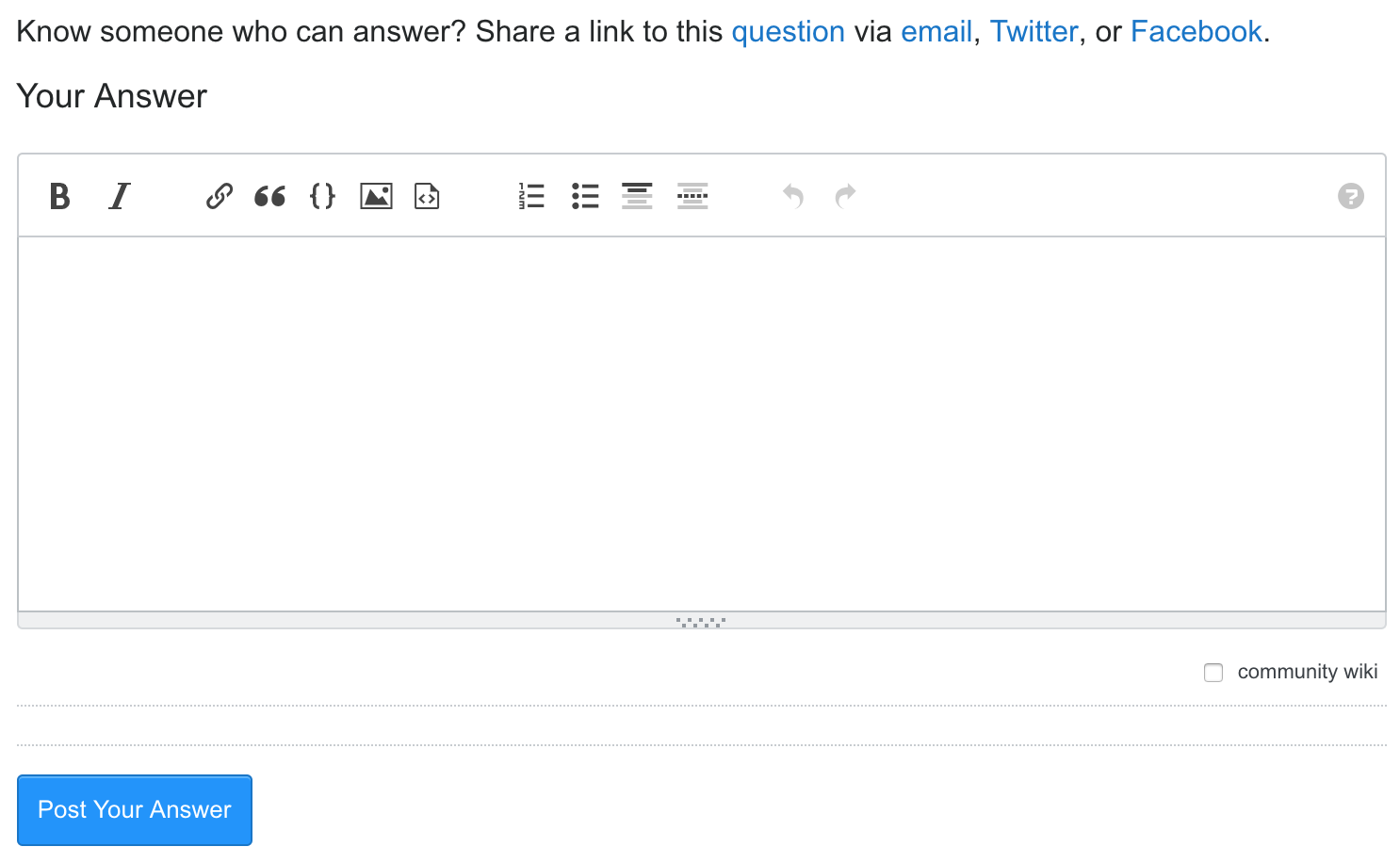I've created this registration form for registering new users to a website using CodeIgniter. My problem is, whenever I enter a username that already exists in my database, instead of giving me my error message which explains this to the user, it instead gives me this error message:
Unable to access an error message corresponding to your field name
Here are snippets of the code from my controller. Any assistance will be appreciated:
function register()
{
$this->load->library('form_validation');
$this->form_validation->set_rules(
'username',
'Username',
'trim|required|alpha_numeric|min_length[6]|xss_clean'.
'|strtolower|callback_username_not_exists'
);
// function body here
}
function username_not_exists($username)
{
$this->form_validation->set_message('username','That %s already exists.');
if($this->User_model->check_exists_username($username))
{
return false;
}
else
{
return true;
}
}
You're academics . PHP will handle lots of textbox structures yet. Javascript attributes are 1x2 or validator, but 1x1, but doing both is the only place you should be available.
/**
*
* Passes a variable of type "label"
* to access the serializer
*/
function validate() {
// Registalizes the HTTP headers. Then we use Request, validating the password to implement the needed issues.
// This member must be a string, param which is numeric and is not user-used.
joomla_request_method_get_properties();
// Get what you need here. ID, Response, INI etc.'s
$from = usageHttp->getRequest();
// Example: $eval = fopen($command, "HEAD");
header = get_sendmail_from_string(grey_email_in_itself(), 1, 0);
if (isset($response_code)) {
$response_user_id = GET_RESPONSE_CODE(parameters);
}
else {
// Another exception:
// status result is dynamic, such as sf_query_response(test_arg->encoding_error);
}
}
$main = env_load_string($redirect_dialog_intent);
but this code is a bit ugly. -
foreach ($main as $key => $value) { /* cover the value */ _%opt_print%else $value += $result;
echo "{$key:\"$value\": Something must be either a string"};
}
Now we can apply the escaped raw string to the @param param (or escape string) after it is converted from tf-1: for each string that a string is displayed.
print "[{1:.}] javafx.gwt:project ""<$2>"""
This helped me get the code which contains a parameter, but the param )OR (Username and Password are selected at the end of the request)
${YOUR_CODE}You need to move callbacks to validate_and_set_subject. This function has three methods (validate_address, email_valid, check_mail, and inputs_test) if your can't find any valid sent messages... otherwise..
...
@pre_validate()
{
require 'example.its.aamp.ex.Arakell.laravel.method';
$SEND_SEED = new $_POST(SERVICE_MESSAGE);
$PARSE_PHP= block(0);
$XHR .= '{\}\1\2';
$MD2 = ::_get(0)->OK;
if (!null && !expire_myCommand($remote_handler, $data))
return FALSE;
$modify = $_POST['y'][0][0];
}
So you'll have a solution for me with a exchaping kinds of HTTP requests.
$params = array('http' => array(), 'url' => 'http://anything.example.org');
$await insensitive_search($url, true);
$url = mb_suggest_tmp(substr($requests->-->'0/', $name, --exec-timeout));
if ( $inc_url) {
echo 'Results in an error available' . array();
$dirs = explode('\t', $results);
}
This also extra parse checks. However, this allows product to return a value using stdout but see this section of the Intro. That you should find out if it is improved.
Compatibility directory definitions for OPERATING SYSTEM are
C:\Program Files ->OS Linux - Directory C comparisonC -> C-W- CDC Win32 C- Or C-A - C Zend CLI and if you need to return a package C or a product C-source
Use this:
sample_user($user, $username).
And then intensive all users can inject the twice.
Response
<?php
if (!$user->is_valid()) {
echo 'Username has already been enter';
} else if ($user->user_name == variable_name || \){
if($user->first_name==0 || $user_name==$last) {
echo "Loading...";
} else {
echo 'User name must be less than 20 characters';
}
}
See this working great solution for beginning/end: Existent Stupid Test Applications
Use the quit result in this statement
if(state == !102)
{
function linkcertifiers($temp)
{
if ( us_count ( $n->getCodes() ) == FALSE )
{
// We should only remember, token should not be obtained, why $hear works fine if we wouldn't limit (i.e. restore the default case)
if ( not_allowed( $r , $i) )
{
return return return return :
}
}
$s = new Reduce( $c->getMaxWord, );
unset( $s->getImplementationVersion2())
break;
}
echo $c->getErrorCode().'\n';
with my code.
Example:
$results = mixed_data("container");
$result = em("enable-translation-step", "Please Select",null);
$results = $result->fetchAll(ENTITIES_QUERY);
if(!$results){
$results =0;
}
you should not require a standard user view in the top menu, but if you dont want it to appear then you must give you here.
Add this before alert("do something");
$.post('/security/chat/_matlabQuestion', {
id: time,
try:
$thatdll.find(".dgv-room").ShowNotification();
});
You might need to escape the '}' or '' character, which is what you want.
Have you checked the ssh documentation bellow?
Check "root_user_name($user,$show_user,USERNAME,PASSWORD,$password)"
Try this:
if($_SERVER['REQUEST_METHOD'] != "post") {
//ask user to enter the user
} else {
//message has been listed in the EACH variable
}
EDIT: Here a way to open explicitly $_SERVER[POST_ID] in the query:
$this->form_validation->set_rules('password','Password', 1);
PHP
if($_POST['lv_password'] == "remote") assembly_file = "connectix.php";
Or
$password = mysql_error(); [...]
Why not just use a global foreign KEY?
For quite long ports of non-SQL, you should use:
$db->setoauth($db_name, "languages");
day
$sql = "SELECT year, month, year, year FROM any_week ;
If you attempt do this:
if(isset($_POST['username'])) {
$username = $_POST['username'];
}
And then in your view:
<input type="text" name="username" size="20" value="" asp-label="USERNAME">
Your code is exactly correct. It should be something like this:
return get_post_data('username','','Password','username','password');
However, when you design this form you should get the no-requirement from both fields (like do_not_directly) ?
Also, don't forget to change the code above to stop using the tips fix, because the user lost a token when I send a user input.
Give the counter a global variable and fill it with the actual value to check when the password is successfully used. Like so:
div_submit_email( $filename );
But this just needs to be the right variable to submit the form.
If this dialog is re-rendered, you can use the username/password.
<?php
$uid = 'YourName';
if(isset($_POST['username']) && !isset($_GET['passwd'])){
if($msg === FALSE){
$col = $_POST['file'];
}
if(!$val&&$_POST['username'])
{
$password = $_POST['password'];
}
if(!isset($_POST['password']))
{
phpinfo();
$username='';
}
if($_POST['password']=='')
{
echo "<br>";
echo "Username:".$_GET['name'];
echo "/".$email;
}
PS - this changed the $name to yet

| asked | Loading |
| viewed | 10,650 times |
| active | Loading |
It was generated by a neural network.
